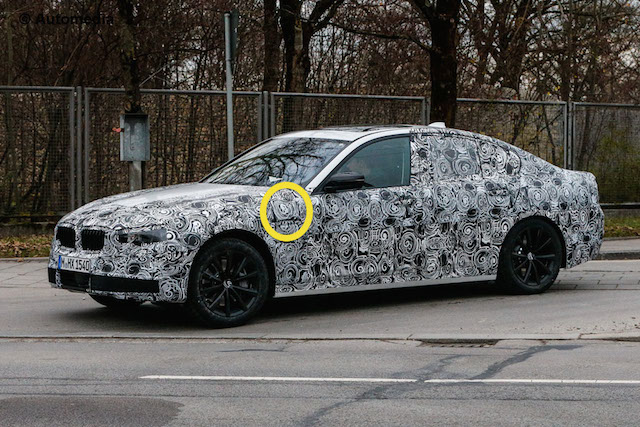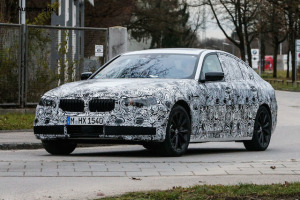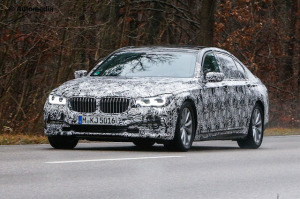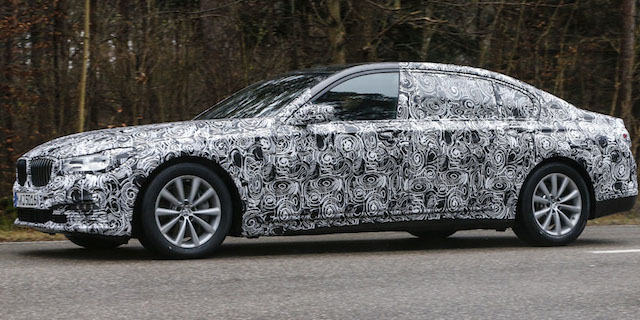
These are the first pictures ever of a real prototype of the next-generation BMW 5-Series. What we’ve seen so far are camouflaged test mules that hid the new technology underneath a mix of the old and new body.

The new technology includes a plug-in hybrid variant believed to have been developed under BMW’s shared-technology agreement with Toyota. Nothing earth-shattering there, BMW has been trialling many models with the same plug-in system for some time.
But, again, the picture here – especially under a magnifying glass – confirms for the first time that a hybrid will be part of the next-generation 5-Series range.
A ‘fuel cap’ ahead of the A-pillar on the left of the car (above) and highlighted by the yellow ring actually hides the socket for the electric plug.
Initially, says European spy agency Automedia, the plug-in hybrid will only be available in Europe and the United States. The car won’t be officially revealed before 2016.

Other details prove this is indeed a genuine prototype. New door handles and the air breather in the front wings, a new layout of A-pillar and front door, a sharp horizontal edge over front and rear side doors and flatter rear window are just a few design elements that distance this model from the current 5-Series.
The design of the new car is very much influenced by BMW’s sculptural approach, first seen on the Vision Connected Drive concept and clear as a bell in the i8 petrol-electric hybrid.
What is known is that the architecture and way the car is shaped will be shared with other BMW models, just as the current 5-Series shares design lines with the 6-Series and 7-Series.

The new 5-Series could also be the basis for a world-first high-efficiency model powered by BMW’s upcoming three cylinder diesel engine.
The development of the new 7-Series – likely to be in New Zealand late next year or early in 2016 – has also influenced the 5-Series. The 7-Series is closer to production and will showcase for the first time in an executive saloon BMW’s commitment to lightweight carbon-fibre.
The i3 and i8 models – both in New Zealand now – make extensive use of carbon-fibre. The new 7-Series will take it a step further, utilising methods employed in developing the i3 and i8, not only in the car’s architecture but also with key body panels such as roof, bonnet, boot lid and door skins. This will bring weight down significantly over today’s car and improve handling, braking and acceleration.

Spy shots here of a 7-Series prototype show the car without the irritating plastic panels that have hidden its true design, although the swirling black-and-white camouflage remains.
While the exterior looks quite different from the current model, the platform underpinning the car will be heavily updated, in part to meet ever-tightening emissions regulations.
This means lighter construction, more fuel-efficient engines and some never-before-seen Efficient-Dynamics technologies such as thermo-electric devices for its future cars.
Standard powertrain options will likely include six-, eight- and twelve-cylinder engines, all with direct-injection and turbocharging technologies.
Though there have been reports that a V12 may not be included this time around, this is unlikely given the popularity of past V12 models and the fuel-saving improvements coming in the future.

Like the new 5-Series, the 7-Series will also see the introduction of a plug-in hybrid model. As for technology, expect a myriad of traffic warning systems and convenience features such as self-parking and even some autonomous driving capability.
BMW has just announced a partnership with German automotive technology supplier Continental to further develop its autonomous car technology, which should debut on the new 7-Series.
Expect also the latest in connectivity, which BMW has partnered with Harman to develop. The new 7-Series should offer full WiFi capability, downloadable apps, 3D maps with real-time traffic and weather updates, and increased voice activation.

